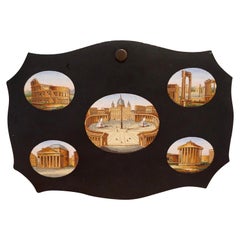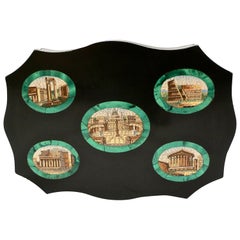Ancient Roman Desks
Recent Sales
Antique Mid-19th Century Italian Grand Tour Paperweights
Marble
Antique Late 19th Century Italian Grand Tour Paperweights
Slate
Ancient Roman Desks For Sale on 1stDibs
How Much are Ancient Roman Desks?
A Close Look at Grand-tour Furniture
For 18th-century young British noblemen, no education was complete without a year on the Grand Tour. Although it had no official route, the Grand Tour focused on places foundational to European art, literature and architecture, including sites in France, Germany, Switzerland and, most importantly, Italy. It was an opportunity not just to witness the roots of the classics they had studied but also to take some of it home. Grand Tour furniture was among the souvenirs.
Grand Tour furniture ranged from marble architectural models replicating ancient wonders to actual antiquities often taken illicitly, leaving a legacy of looting still being unraveled today. Other items reflected the artistic richness of the Renaissance cities and other destinations. In Italy, this included scagliola tables and pedestals mimicking marble as well as tabletops and wall panels embedded with pietra dura hard stone mosaics.
Furniture was also developed to display Grand Tour purchases in the owner’s home, presenting them as a cultivated and well-traveled person. Mahogany collector’s cabinets held objects like intaglio moldings of coins and seals while others had specialized drawers that framed pietra dura panels.
Many objects were specifically produced for Grand Tour collectors. Often accompanied by retinues on journeys lasting months or years, the elite travelers, the wealthiest of whom extended their trips to Egypt and the Holy Land, required artful personal mementos befitting the experience. For example, Grand Tour micromosaics — small artworks, most not more than two inches wide — arose from the entrepreneurial impulses of artisans who had trained in the Vatican’s workshops.
Grand Tour journeys would help inform a range of decorative styles such as neoclassical, Rococo and Adam style. (Architect and designer Robert Adam toured Italy and France for five years.) The Grand Tour flourished at a time of economic prosperity and political stability, but the French Revolution in 1789 brought it to an end. Yet as the tradition faded in popularity in England, the rising wealth of the United States led to an increase in tourism across the Atlantic and a similar passion for collecting to show one’s worldliness.
Find a collection of Grand Tour decorative objects, wall decorations, lighting and other furniture on 1stDibs.
Finding the Right Paperweights for You
While any heavy object can be used to hold loose papers, there’s nothing as ornate yet perfectly functional as a paperweight. Antique, new and vintage paperweights can unobtrusively enhance the ambience of a room or act as a colorful conversation starter. On a desk or writing table, it can contribute a subtle sense of style.
Glass paperweights emerged in Europe in the mid-19th century. Early paperweight artisans like Venetian glassmaker Pietro Bigaglia often crafted them with a design on the inside. By the early 1900s, paperweight objects became even more popular through innovative iterations by artists like Louis Comfort Tiffany.
As the paperweight became both a luxury and utilitarian object, creators used a variety of materials to set their wares apart. Today, in addition to the classic glass versions, paperweights are made of metal, wood, ceramic and stone.
A vast selection of paperweights as well as a whole range of other desk accessories can be found on 1stDibs — browse by type, price, period, material or style, from Art Deco and Hollywood Regency to metal and glass. Reflecting their widespread appeal, paperweights are available in a diverse array from across the globe, including Italy, France and North America, as well as examples by leading designers and brands such as Fratelli Toso, William Guillon and René Lalique. Whether an office or a study needs a touch of something vintage or a mid-century modern twist, there are paperweights to suit every taste.

